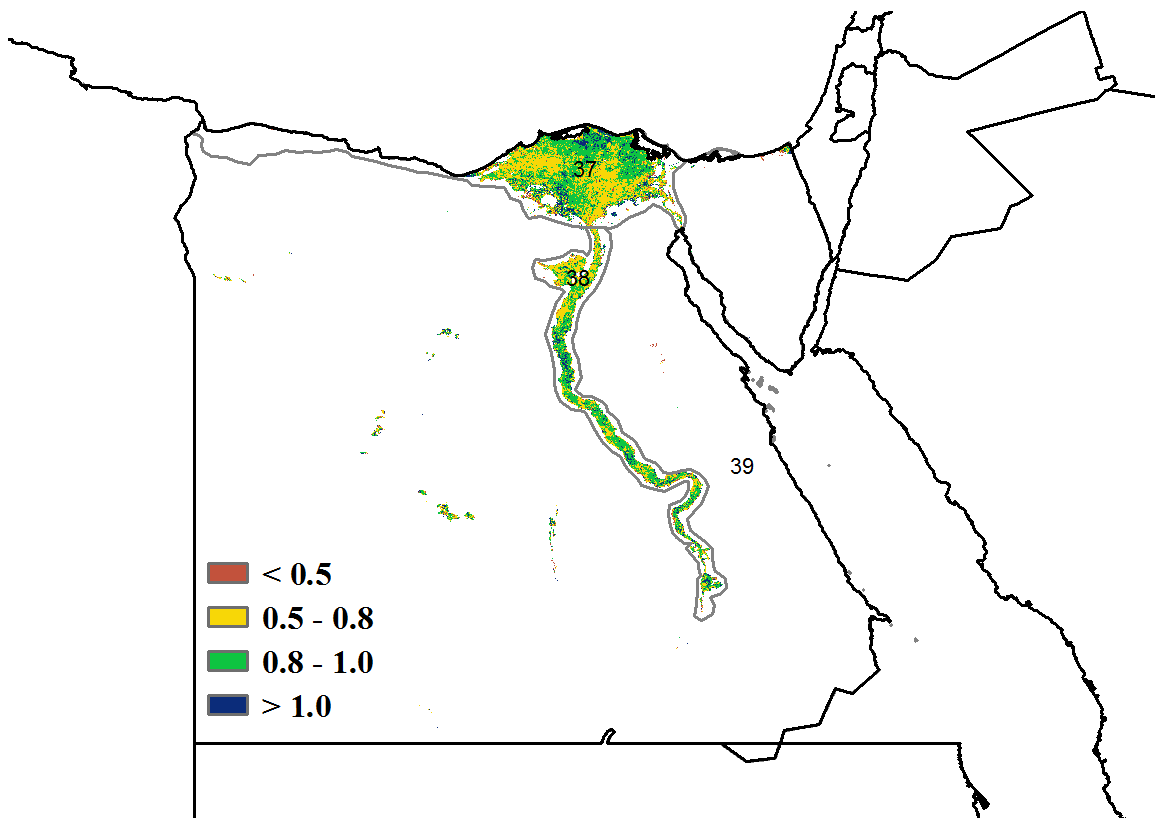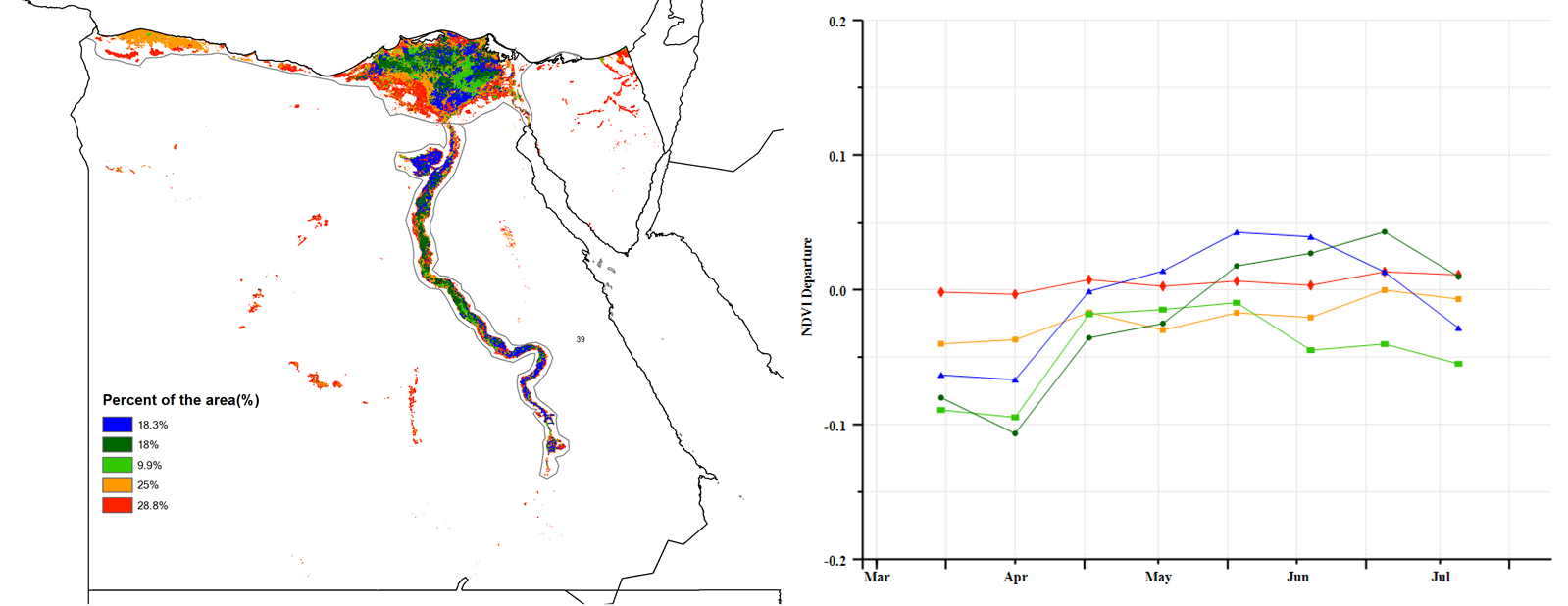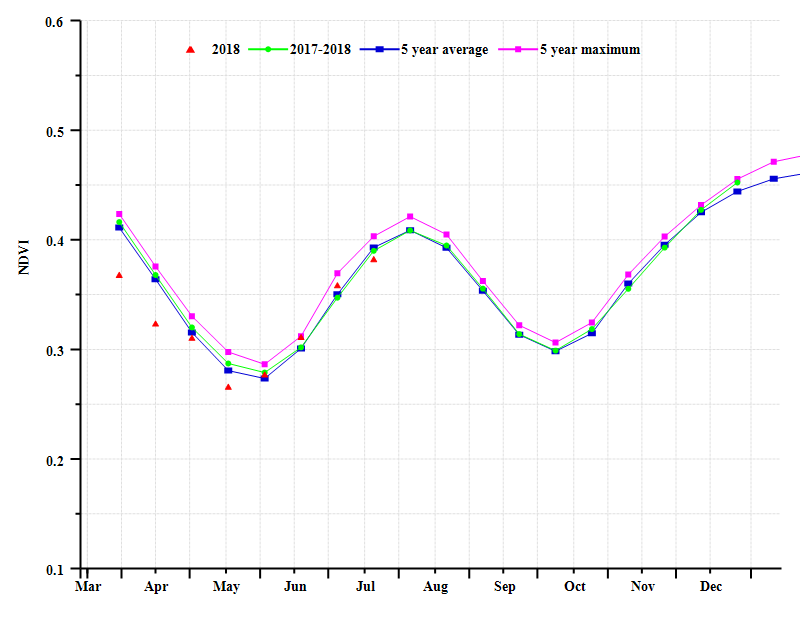
Bulletin
wall bulletinMenu
- Overview
- Country analysis
- Argentina
- Australia
- Bangladesh
- Brazil
- Canada
- Germany
- Egypt
- Ethiopia
- France
- United Kingdom
- Indonesia
- India
- Iran
- Kazakhstan
- Cambodia
- Mexico
- Myanmar
- Romania
- Russia
- Thailand
- Turkey
- Ukraine
- United States
- Uzbekistan
- Vietnam
- South Africa
- Afghanistan
- Belarus
- Mongolia
- Sri Lanka
- Zambia
- Mozambique
- Kenya
- Angola
- Hungary
- Italy
- Morocco
- Nigeria
- Pakistan
- Philippines
- Poland
Authors: 超级管理员 | Edit: Changsheng
During the April to July 2018 period, winter wheat reached its final stage (pre-harvest or harvest), while the summer crops (e.g. maize and rice) were sown and were still growing. Nationwide agro-climatic indicators show that rainfall (RAIN) and TEMP were average (TEMP was 25°C, 0.5°C above the 15YA). The radiation (RADPAR) was 1553 MJ/m2, -3% below 15YA, while the estimated biomass (BIOMSS) was 57 gDM/m2, 47 % above 5YA. Generally, crops being irrigated, RADPAR is the main limiting factor.
The spatial NDVI patterns show that the conditions of 71% of the total cropped area were below the 5 years average from April to mid-May, after which crop condition became either above or close the 5YA conditions. The maximum VCI map shows poor and fair crops (< 0.5 and 0.5 to 0.8) are mostly located in the Nile Delta, whereas the value of the maximum VCI for the whole country was 0.7. The Cropped arable land fraction (CALF) was only 2% less than the 5YA nationwide.
CropWatch estimates that crop conditions was moderate during the analysis period. The variation in CropWatch-estimated maize, rice, and wheat production was lower (-2.4%, -2.9% and -1.6%, respectively) compared to the previous season.
Regional analysis
Egypt can be subdivided into three agro-ecological zones (AEZ) based mostly on cropping systems, climatic zones, and topographic conditions. Only two of them are relevant for crops: the first zone is the Nile Delta and Mediterranean coastal strip, while the second zone is the Nile Valley.
Rainfall was seasonally low in both AEZs (6 mm in the Nile Delta and Mediterranean coastal strip and 25 mm in the Nile Valley. Since virtually all Egyptian crop production is irrigated, rainfall makes little change in the outcome of the season, although additional water usually has a beneficial effect. RADPAR for both zones was (-3% and -4%, respectively) slightly below average; the BIOMSS index shows an increase (25% and 37% above the 5YA, respectively) for both zones.
The NDVI-based Crop condition development graphs indicate below average conditions in the period from April to mid-May for both zones after which crop condition for the two zones returned to be close to or above average, especially in Nile Valley zone where the crop condition even exceded the last 5 years maximum after mid-May, in agreement with the VCIx values (0.7 and 0.8, respectively).
 (a). Phenology of major crops
(a). Phenology of major crops


(b) Crop condition development graph based on NDVI (c) Maximum VCI

(d) Spatial NDVI patterns compared to 5YA (e) NDVI profiles


(f) Crop condition development graph based on NDVI (Nile Delta (left) and Nile Valley (right)).
Table 3.23. Egypt’s agroclimatic indicators by sub-national regions, current season's values and departure from 15YA, April-July 2018.
| RAIN | TEMP | RADPAR | ||||
| Region | Current (mm) | Departure from 15YA (%) | Current (°C) | Departure from 15YA (°C) | Current (MJ/m2) | Departure from 15YA (%) |
| Nile Delta and Mediterranean coastal strip | 6 | -5 | 24.7 | 0.5 | 1544 | -3 |
| Nile Valley | 25 | 64 | 27.4 | 0.3 | 1573 | -4 |
Table 3.24. Egypt’s agronomic indicators by sub-national regions, current season's values and departure from 5YA, April-July 2018.
| BIOMSS | CALF | Maximum VCI | |||
| Region | Current (gDM/m2) | 5YA Departure (%) | Current(%) | CALF departure (%) | Current |
| Nile Delta and Mediterranean coastal strip | 48 | 25 | 1 | 0 | 0.7 |
| Nile Valley | 71 | 37 | 1 | -2 | 0.8 |
Table 3.25. CropWatch-estimated maize, rice, and wheat production for Egypt in 2018 (thousand tons)
| Production 2017 | Yield variation | Area variation | Production 2018 | Production variation | |
| Maize | 5918 | -6.9% | 4.8% | 5774 | -2.4% |
| Rice | 6545 | -6.5% | 3.9% | 6358 | -2.9% |
| Wheat | 10963 | -6.6% | 5.4% | 10790 | -1.6% |
